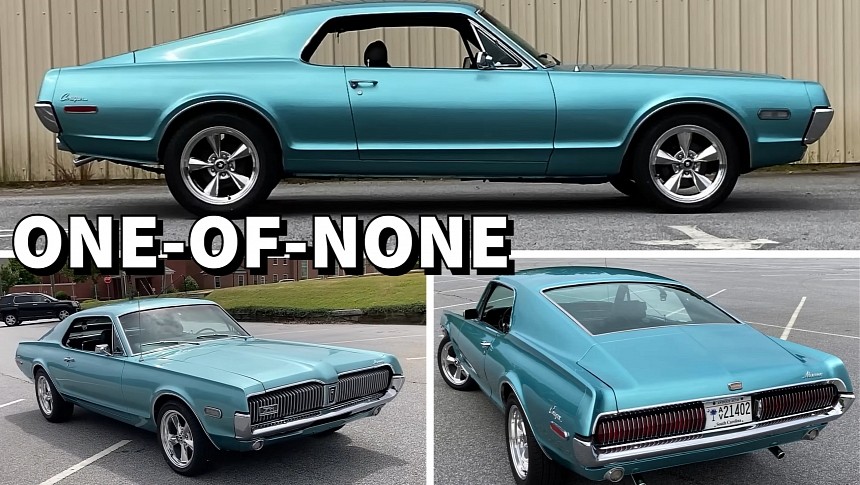Introduced in April 1964, the Ford Mustang kickstarted the pony car segment. Granted, the Plymouth Barracuda debuted two weeks earlier, but the Mustang's massive popularity prompted General Motors to create the Chevrolet Camaro and the Pontiac Firebird.
With more than 500,000 Mustangs delivered in 1965, Ford decided to let the Lincoln-Mercury division have a go at the pony car market. One year later, the Mercury Cougar became a premium alternative to the Mustang.
Sporting a unique and decidedly more aggressive front fascia, the Cougar offered more convenience features than the Mustang. At the same time, it was tuned to deliver more comfort to the point where it almost rivaled the Thunderbird. The engine lineup was obviously shared with the Mustang sans the entry-level inline-six.
But even though the first-generation Cougar was essentially a re-bodied Mustang with extra goodies, it was offered in only two body styles: the hardtop and the convertible. It's unclear why Mercury didn't make a fastback version (some say Ford opposed the idea), but the 1968 Cougar you see here proves that the muscle car would have looked gorgeous with a sloping roof.
What's the deal with this one-of-none Cougar fastback? Well, it's not a concept car or a prototype that didn't make it into production. It's an enthusiast's idea of turning a rusty classic into a unique rig bound to turn heads.
A full-blown custom project completed at a professional shop, the fastback was put together by marrying the front section of a 1968 Cougar to the rear of a 1967/1968 Mustang. It's obviously more complex than that, but the rear fenders, the trunk lid, and the roof are clearly sourced from the Cougar's Ford-badged sibling.
The owner also points out that the roof was lowered from the original height, but it's not exactly a chopped top, so it works nicely with the sloping rear end. The Cougar rides on a set of vintage-looking 17-inch wheels (larger than the 1960s Cougar/Mustang standard), while the pearl blue paint is reportedly based on a Cougar factory color. It's similar to the Diamond Blue hue Mercury offered in 1968.
There's no info on whether the customization included some engine work, but the owner mentions a 289 engine. Assuming it's a standard Cougar mill, we're looking at a 289-cubic-inch (4.7-liter) V8 of the Windsor variety. The car's entry-level mill in 1967, the 289 was available with a two-barrel carburetor and 200 horsepower or a four-barrel carb and 225 horses. The engine was replaced with a 302-cubic-inch (4.9-liter) V8 in 1968, but it returned with a lower compression ratio mid-year. Output went down to 195 horsepower.
If the engine is still stock, this Cougar is far from exciting output-wise, but it doesn't bother me one bit. The Mercury looks stunning with a fastback roof, and the quality of this build is impressive, to say the least. And yes, Ford should have allowed Mercury to offer a fastback.
Sporting a unique and decidedly more aggressive front fascia, the Cougar offered more convenience features than the Mustang. At the same time, it was tuned to deliver more comfort to the point where it almost rivaled the Thunderbird. The engine lineup was obviously shared with the Mustang sans the entry-level inline-six.
But even though the first-generation Cougar was essentially a re-bodied Mustang with extra goodies, it was offered in only two body styles: the hardtop and the convertible. It's unclear why Mercury didn't make a fastback version (some say Ford opposed the idea), but the 1968 Cougar you see here proves that the muscle car would have looked gorgeous with a sloping roof.
What's the deal with this one-of-none Cougar fastback? Well, it's not a concept car or a prototype that didn't make it into production. It's an enthusiast's idea of turning a rusty classic into a unique rig bound to turn heads.
A full-blown custom project completed at a professional shop, the fastback was put together by marrying the front section of a 1968 Cougar to the rear of a 1967/1968 Mustang. It's obviously more complex than that, but the rear fenders, the trunk lid, and the roof are clearly sourced from the Cougar's Ford-badged sibling.
The owner also points out that the roof was lowered from the original height, but it's not exactly a chopped top, so it works nicely with the sloping rear end. The Cougar rides on a set of vintage-looking 17-inch wheels (larger than the 1960s Cougar/Mustang standard), while the pearl blue paint is reportedly based on a Cougar factory color. It's similar to the Diamond Blue hue Mercury offered in 1968.
There's no info on whether the customization included some engine work, but the owner mentions a 289 engine. Assuming it's a standard Cougar mill, we're looking at a 289-cubic-inch (4.7-liter) V8 of the Windsor variety. The car's entry-level mill in 1967, the 289 was available with a two-barrel carburetor and 200 horsepower or a four-barrel carb and 225 horses. The engine was replaced with a 302-cubic-inch (4.9-liter) V8 in 1968, but it returned with a lower compression ratio mid-year. Output went down to 195 horsepower.
If the engine is still stock, this Cougar is far from exciting output-wise, but it doesn't bother me one bit. The Mercury looks stunning with a fastback roof, and the quality of this build is impressive, to say the least. And yes, Ford should have allowed Mercury to offer a fastback.












